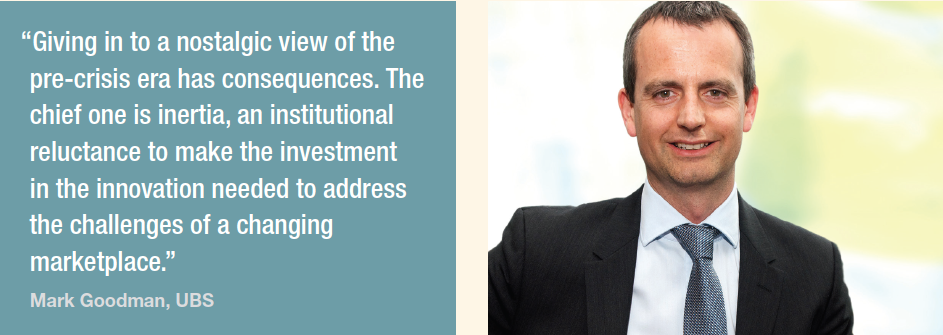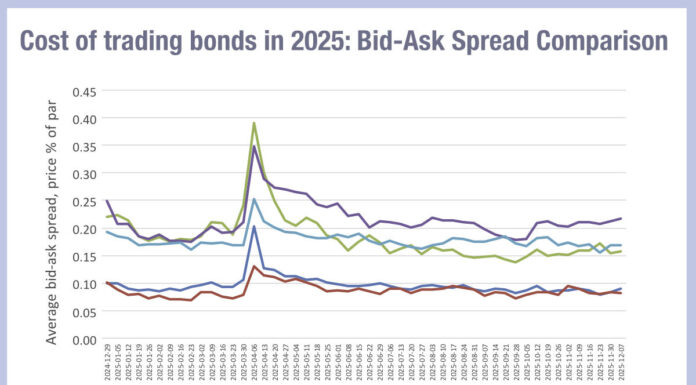THE PERILS OF NOSTALGIA.
Mark Goodman, Managing Director, Global Head of Electronic Trading – FX, Rates and Credit at UBS.
‘Nostalgia’ is a modern word, coined by a Swiss physician in the 18th century as the designation of a mental disorder. Johannes Hofer of Basel applied this diagnosis to soldiers on military campaigns who suffered intense homesickness, leading to debilitating depression or even death. In 1754, French army medical journals listed nostalgie as an affliction of troops and a threat to military effectiveness.
Over time, ‘nostalgia’ shed this harrowing clinical definition, morphing into an everyday expression for our longing for the Good Old Days. This pining for more familiar times usually stems from frustration and impatience with change. Faced with the challenges of the present, our minds escape to an idealised past.
 This idealised past is, of course, the product of selective memory. As the American ‘cowboy philosopher’ Will Rogers cracked in the depths of the 1930s Depression: “Things ain’t what they used to be, and probably never was.”
This idealised past is, of course, the product of selective memory. As the American ‘cowboy philosopher’ Will Rogers cracked in the depths of the 1930s Depression: “Things ain’t what they used to be, and probably never was.”
Thinking, in some corners of banking, has slipped into a form of nostalgia, harking back to the period before the credit crisis as a Golden Age – an era predating the regulation and institutional realignments that the industry is coping with today. Memories of hefty returns on equity burn particularly brightly in this form of nostalgia.
Few would argue with the view that the pre-crisis structure had positive features and functioned effectively in many cases for banks and their clients. On the other hand, nostalgia’s selective memory tends to overlook its deficiencies. A cold-eyed recollection has to bring into question whether banks and their clients understood the true costs of their pre-crisis business models.
Did banks – and investors in their equity – appropriately price the risk of carrying substantial inventories of credit instruments on their balance sheets? Did they accurately gauge the real costs of managing their holdings’ volatility, and the potential for regulatory and legal fallout from major drawdowns? Did their clients appreciate the true costs of accessing this inventory through a limited number of bilateral relationships? Clarity of hindsight suggests not.
Giving in to a nostalgic view of the pre-crisis era has consequences. The chief one is inertia, an institutional reluctance to make the investment in the innovation needed to address the challenges of a changing marketplace. The economic penalties of inertia are well established, as banking is hardly the only industry that has had to face up to the need to re-engineer the way its delivers value to its customers.
Among the first examples to come to mind is the European automobile industry. In the middle of the 20th Century, the UK auto industry boasted the world’s most famous brands, dominating the market for luxury and sports cars – Rolls Royce, Bentley, Rover, Jaguar, to name a few.
As the turn of the century approached, these iconic automobile brands were passing out of UK ownership and into the hands of non-UK auto groups, with BMW, Volkswagen and Tata Motors among the new owners. For a variety of reasons, the prior ownership had not moved to adopt innovative techniques in inventory management and lean manufacturing. In contrast, other manufacturers had taken on those challenges.
Among the most successful companies to do so was Porsche. In the early 1990s, Porsche recruited a team of Japanese consultants to retool its product development and manufacturing. In an interview with The New York Times in 1996, Porsche’s CEO described the consultants’ dismal initial findings. Touring a Porsche plant, one of the Japanese engineers, Chihiro Nakao, was dismayed to find that the automakers’ assembly line looked instead like “a dark warehouse.”
“On either side were shelves eight feet high with huge parts bins filled with 28 days of inventory,” it was reported. “To get a part, workers often had to climb ladders, wasting enormous amounts of time.”
By the mid 1990s, Porsche had begun to re engineer inventory management and assembly: “There are no bins of spare parts through which workers have to dig. The parts needed for assembly hang on carts that are pulled down the line with the engines, so that workers do not have to leave their work space.” Assembly time for one of the Porsche’s popular models was cut sharply, to 72 hours from 120 hours. Manufacturing errors per car fell by half as well, according to reports.
Banking is not automobile manufacturing, but our industry is coping with a comparable need to rethink our approach. Experimentation will be needed to find the best model, and we are still some ways from a definitive view of what works and what does not. Much will depend on how effectively the buy side and the sell side embrace changes in mindset and behavior.
Some may argue that there has been no dearth of experimentation. More than 90 different platforms have sprung up in recent years, often proclaiming themselves ‘the liquidity solution’ for the challenges of the current market structure.
Truth be told, some of these startups are the typical false prophets that emerge in times of rapid change, relying on repackaged, traditional approaches unlikely to prove transformative. Scratch their shiny digital surfaces, and you may find an old model of doing business. In certain cases, principal trading continues to drive their activity, albeit in a technology wrapper. While some new platforms show truly innovative thinking, only a few have sufficient scale, reach or technical means to create significant value for their clients in today’s market environment.
In the future, the most successful models will look significantly different from those before the crisis, and different from many of the ‘alternative’ platforms now. The winning formula will preserve the enduring, client-centric principles of banking while offering a more efficient, cost-effective approach to engaging with the evolving market structure. The leaders’ business models will have at least three important features:
- A focus on delivering quality execution in ways that are verifiable and transparent to clients. As in a manufacturing process, systematic monitoring and analysis of trading outcomes plays an important role in achieving quality and providing transparency around results.
- Dynamic access to a global network that encompasses the diverse sources of liquidity that characterise the post-crisis market landscape. Principal trading will remain part of banks’ capabilities, but the primary objective is to create maximum opportunity for clients to interact with the appropriate types of liquidity needed to execute their investment strategy.
- Advanced technology and trading support that simplifies the client’s ability to access this network and gives them significant control over how their orders are managed. All trends point to continued growth in electronic trading and the use of advanced trading techniques across major asset classes. The buy side feels increasingly comfortable employing these tools, and looks to banks as partners in helping them deploy and manage these capabilities.
History holds few – if any – examples of markets reverting to prior forms. One of the most exciting aspects of our industry is the dynamism of global markets and the challenges posed by change. Nostalgia for the “never was” only holds back the imagination and commitment needed to deliver compelling value to clients. Better to keep our gaze forward, on the horizon.
The views and opinions expressed in this material are those of the author and are not those of UBS, its subsidiaries or affiliate companies. Accordingly, UBS does not accept any liability over the content of this material or any claims, losses or damages arising from the use or reliance of all or any part thereof.
©Markets Media Europe 2025









